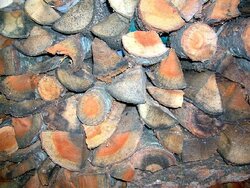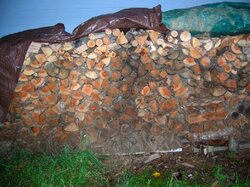I guess the humidity is causing mold to form on the end of some cherry and poplar in my woodpile. This was freshly split and stacked late this winter (Virginia). I'm not that worried but still wish it was so dry that mold wouldn't grow on it. Do you think it is from the humidity or the moisture leaving the wood?
I was worried some rain was splashing up on it and keeping it wet so I lowered down the sides of my tarp about half way (previously I just had the top and a bit over th edge covered).
This is my first batch of my own splits I am trying to season. Should I be concerned?
I was worried some rain was splashing up on it and keeping it wet so I lowered down the sides of my tarp about half way (previously I just had the top and a bit over th edge covered).
This is my first batch of my own splits I am trying to season. Should I be concerned?



